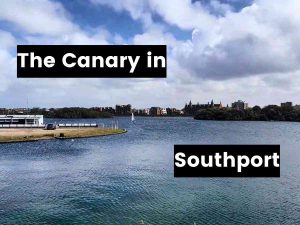The Church of England is obstructing public scrutiny of an offsetting agreement central to its plans to tear up a beloved and biodiverse veteran beech tree at Ripon Cathedral in the city centre. However, the Canary has unearthed the likely identity of the owner of the land tied to the fate of the veteran tree.
Crucially, the private landowner operates a mixed farming business – including thousands of hectares of commercial forestry.
In part one of this two-part series, the Canary explored how Ripon Cathedral has snubbed calls to revise its £8m annex application set to destroy an “irreplaceable” veteran tree in Ripon city centre.
Notably, the article unpacked the Cathedral’s refusal to relocate or downsize its proposed development. Moreover, it detailed North Yorkshire Council’s role in facilitating what campaigners have branded a “sham” of a public consultation.
Now the Canary will investigate the secrecy surrounding its off-site biodiversity offsetting strategy, and what this opaque agreement could mean for the campaigners’ ongoing battle against the project.
Bogus biodiversity offsetting
Ripon Cathedral has submitted a proposal to North Yorkshire Council for permission to build a £8m annex. As the Canary previously detailed, the development would house multiple amenities, including a new song school, offices, toilets, and an 80-seat refectory. For part of this plan, it has put forward a biodiversity offsetting strategy.
However, as the Canary’s Tracy Keeling has detailed before:
Biodiversity net gain (BNG) is the government’s controversial metric to facilitate continued development in nature-rich areas during the extinction crisis. It enables developers to secure a green light to destroy existing wildlife habitat. They can do so as long as their plans include promises to replace that biodiversity elsewhere and, in many cases, increase it overall.
In particular, this biodiversity offsetting scheme is a central pillar to the Cathedral’s plans to rip up the veteran beech tree. Specifically, national planning policy requires developers to provide nature compensation when they cannot avoid destruction of “irreplaceable habitat” – in this instance, the veteran beech.
Moreover, as the Canary pointed out in part one, multiple statutory consultees have set out why they do not consider this unavoidable.
Nevertheless, the offsetting site sets aside a separate parcel of land for woodland-pasture habitat. Essentially, the site is supposed to offer a net gain – an increase – in biodiversity.
Ripon Cathedral: behind fences
The Cathedral’s proposal for a one acre woodland-pasture would provide new habitat for wildlife. However, while it might eventually add to global biodiversity overall, it does little to uplift nature in the city itself.
Significantly, the pocket of land is situated 5.6km from Ripon. As Save the Trees campaigner Jenni Holman told the Canary:
It is in a farmer’s field. You can drive for 20 minutes, and then you have to walk across fields for 10 minutes to find that place.
What’s more, communities in Ripon will not see the benefits of this new woodland-pasture. This is because the land itself is privately owned.
Tellingly, various statutory consultees have also disparaged the mitigation scheme itself. For instance, the council’s arboriculturalist argued that:
Planting trees within Azerley is not supported as this does not link to the development.
Meanwhile, the council’s ecologist stated that while the location was suitable in “ecological terms” for growing trees that might become veterans, this would be:
likely to take at least 200-300 years, which is the reason why veteran trees are considered effectively irreplaceable.
As such, the ecologist said that:
For this reason this bespoke compensation would only be acceptable as a “suitable compensation strategy”, if decision-makers conclude, in accordance with the NPPF (180a), that there are “wholly exceptional reasons” which justify the loss of the veteran tree.
Conflicting information
Regardless, in step with its overall refusal to entertain an alternative site for the annex, the Cathedral has so far ploughed ahead with this as its mitigation strategy anyway.
Initially, it proposed to plant an acre of trees at a site near Studley, some 5.6km outside of Ripon. Then, its leaflets advertised its promise to plant “up to 300” trees outside the city.
However, campaigners have underscored the ambiguity surrounding the scheme. In particular, Holman and others have argued that the Cathedral’s information on it has been “conflicting”, pointing out that:
For the majority of 2023, the Cathedral claimed that this off-site area would be ‘at Studley’, this changed in 2024 to ‘near Studley’ and now the Cathedral state ‘outside the city.’
In December 2023, the Cathedral told Yorkshire Bylines that “due process is taking its course and all relevant details will be put into the public domain at the appropriate time”.
But in February, Holman noted that the Cathedral has since refused to disclose this information, telling campaigners that:
Regarding the off-site land for planting trees: there is an agreement which is between the private landowner and the Cathedral and is a private matter.
So, the Save the Trees campaigners challenged this. In the letter, they also argued that:
As this ‘off-site planting’ is supposed to be compensation to the people of Ripon for the trees felled at Minster Gardens, it is not a ‘private matter’, but very much a matter of public interest.
Naturally, the Cathedral hasn’t disclosed any further details to date.
Ripon Cathedral: plantation for profit?
Given this, campaigners have been understandably wary of the agreement. As it currently stands, Holman explained that one of the few details the Cathedral has put out is that the it will be in place for 40 years. As such, she told the Canary that:
there’s also scepticism as to their plans for the trees after 40 years. There’s been mentions of what they think may happen to the trees after
Holman explained that one fellow Save the Trees campaigner and Yorkshire Bylines writer Brian McHugh has been looking into this. McHugh has suggested that the Cathedral could be hiding the commercial endgame for the offsetting woodland:
Why won’t @riponcathedral make public the agreement between them & the l/owner to plant 300 trees to offset felling 11 trees?
Surely it can’t be that these new ones will be fast growing for commercial sale+ more income?@WoodlandTrust @alextomo @alisonclareteal #RiponCathedral pic.twitter.com/Hba6mc7XdH— Brian McHugh 🌏🏳️🌈 (@BrianMcHugh2011) December 17, 2023
And the land next to the site is in fact a plantation forest named Moors Plantation. However, the Canary found that Moors Plantation abutting the proposed planting site is in fact registered to a different landowner. Of course, this doesn’t rule out the possibility that the new woodland could be used for this same purpose.
Wealthy landowner
So, to find out more about the offset site’s prospective future, the Canary dug into the identity of the landowner.
The UK government makes land ownership information available via the Land Registry. So, using available mapping data, the Canary was able to locate the parcel of land and its registered ID. Then, we used the Land Registry’s search function to obtain the title register for the land.
We found that the land is registered to Thomas James Ponsonby Ramsden. Ramsden has close ties to Ripon Cathedral, as its former High Steward.
Of course, he’s a wealthy landowner to boot. Son of former Conservative Harrogate MP James Ramsden, he inherited a vast family estate in Yorkshire dating back generations. Among his inheritance was the family seat at Old Sleningford Hall in Mickley, North Yorkshire.
The exact size of his landholdings is unclear. According to the Times obituary for the late James Ramsden, his father had purchased 2,000 acres of Studley Royal estate near Ripon in 1966. Meanwhile, an article from 1999 in Farmers Weekly stated that Thomas Ramsden farms 1,500 acres of land.
Mixed biodiversity record
Estate size notwithstanding, Ramsden has conflicting biodiversity credentials. On the one hand, he is director of the Hackfall Trust. The non-profit, established by his father in 1988, restored and continues to conserve the Grade 1 listed garden Hackfall Wood.
By contrast, Ramsden has made a living from hacking down woodland elsewhere. Specifically, he operates a mixed farm on his estate, and crucially, this purportedly includes commercial forestry.
Additionally, comparing Land Registry data and satellite imagery, the Canary identified that Ramsden also appears to own a portion of a woodland that adjoins to Moor Plantation. However, we were unable to establish whether he uses this specific woodland for his commercial forestry operations.
And while the public won’t have access to the up to new woodland offsetting site, local hunting groups likely will.
The late James Ramsden reformed the West of Yore hunt and his son has continued the family’s involvement in the cruel industry. Ramsden was formerly master of the West of Yore hunt and has hosted hunt meets from his estate and livery yard. He is also a director of a company of the same name as the hunt.
As such, his land – likely including the proposed offsetting site – is the stomping ground for the local hunting industry.
North Yorkshire Council says…
The Canary contacted North Yorkshire Council for comment. A spokesperson told us:
All planning applications are considered on their merits and subsequent decisions based on national and local planning policies and other material considerations. The potential disposal of land is not material from a planning perspective.
With regard to the query about a Memorandum of Understanding please note there is no memorandum of understanding in place between the council and Ripon Cathedral regarding the possible disposal of North Yorkshire Council land.
We also contacted Ripon Cathedral for comment, but it had not responded at the time of publication.
Ripon Cathedral: greenwashing “at its finest”
In effect then, the Cathedral proposes to offset a cherished urban veteran tree, with an publicly inaccessible woodland on a wealthy landowners estate. There, the landowners’ commercial forestry business raises questions over the longer-term fate of the trees the Cathedral has promised to plant.
Moreover, he hosts an ecologically destructive and cruel industry on his lands – arguably incompatible with the offsetting site’s biodiversity objectives.
Ultimately, Ripon Cathedral’s offsetting agreement is just smoke and mirrors for its plan to tear up the veteran Beech. On X, former Undertones singer and prolific anti-sewage campaigner waded into the debate:
#GreenWashing at its finest.
This is the reality. So much for the rhetoric. https://t.co/y6GcjB1p0Q
— Feargal Sharkey (@Feargal_Sharkey) December 18, 2023
Of course, Sharkey knows a masterclass in greenwashing when he sees it. Now, the residents of Ripon know one too.
Feature image via Youtube – Channel 4 News




